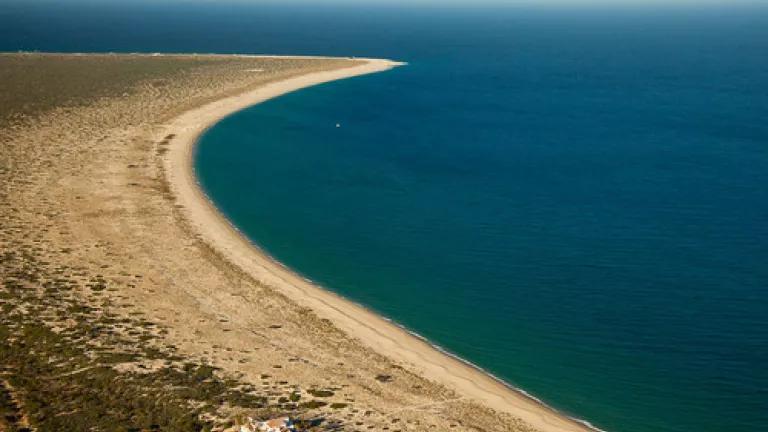
It’s easy to see why the Spanish developer Hansa Urbana set its eyes on the Cabo Pulmo region of Baja California for a proposed tourism resort project known as Cabo Cortés. Unspoiled beaches stretch as far as the eye can see and clear, turquoise waters abound with brightly colored marine life. The problem is that as currently proposed, Cabo Cortés would irreparably damage the natural wonders that are precisely what tourists want to see. The fact is tourism, especially coastal tourism, depends on a healthy environment. This is why potential investors in Cabo Cortés must understand that its many uncertainties and risks would not only harm the environment and local community – but also make it a very unwise investment. NRDC’s new investor risk advisory details key issues potential investors in Cabo Cortés must consider. The good news is there are better alternatives to Cabo Cortés and the local community is eager to work with interested partners in ensuring the long-term, environmentally-sustainable growth of the region.
Photo Credit: Ralph Lee Hopkins
Cabo Cortés is proposed on 3,814 hectares just north of the Cabo Pulmo National Park, home to the most important coral reef system in the American Pacific and considered the “most robust” marine reserve in the world. The proposal entails constructing the equivalent of nearly 30,000 guest rooms, two golf courses, a marina, a private jet port, desalination and waste-water treatment plants and other infrastructure. Investors should understand that the massive Cancun-style project is just not the right choice for this fragile location.
My colleague Amanda Maxwell and I were recently in Mexico to launch NRDC’s new report Hansa Urbana’s Cabo Cortés Project in Baja California Sur: Investor Risk Advisory which looks at environmental, legal, political, market and other risks associated with Cabo Cortés that should give investors pause:
- Environmental impacts could degrade the park and coral reef system
The incredible Cabo Pulmo coral reef is truly what distinguishes this destination from other parts of the Baja peninsula. Simply put, if the reef is degraded one of the main tourist draws would be lost. There is a very high risk that currents would carry sedimentation and other pollutants from the development into the marine reserve’s fragile coral system, which would be unaccetable. In fact, Mexican Environment Secretary, Juan Rafael Elvira, has said Cabo Cortés cannot go forward if it affects the environment.
- Pending legal reviews could set back the project indefinitely
Local groups filed several legal and administrative appeals related to violations of environmental planning ordinances, fragmentation of the project’s approval process, and risks to protected species habitat. These legal actions are still pending and could significantly delay or even prevent implementation of Cabo Cortés.
- Cabo Cortés is highly controversial and political scrutiny is increasing
Investors must be aware that the environmental concerns surrounding Cabo Cortés are not new, nor are they limited to the local community and environmental groups. Back in 2008, when the project was first proposed, certain departments within the Ministry of Environment expressed doubts about the project due to its potential environmental impacts. In light of ongoing concerns about the project’s environmental and social impacts and the pending legal appeals, some Senators are looking closely at the project’s review process in case it failed to comply with Mexican laws.
- Without water there can be no Cabo Cortés
For a tourism project to be commercially viable, especially in an arid region like Baja California Sur, the most important consideration must be access to water. Cabo Cortés proposes to obtain water from an aquifer and desalination plant, yet both proposals have risks that investors should know about. The aquifer may be over-exploited and if the project adversely impacted the local fresh water supply it could mean severe reputational costs for investors. Furthermore, the desalination plant isn’t even approved yet because of concerns that toxic hyper-saline discharge could flow into the park.
- Uncertain market demand in the area
Potential investors also need to consider whether there is even demand for the type of tourism “product” Cabo Cortés represents. Tourism sector data from the nearby Los Cabos resort towns show that annual occupancy rates don’t exceed 65%, indicating that there may already be an oversupply of large all-inclusive resorts and big hotels near Cabo Pulmo.
- Uncertainties about Hansa Urbana
Hansa Urbana, the Spanish parent company of the Cabo Cortés developer may be a risky corporate partner. In Spain, some of its projects have been highly controversial and there are some pending investigations, including into alleged tax fraud.
It’s not a choice between Cabo Cortés or nothing at all
Cabo Cortés is an ill-conceived project that doesn’t belong near one of Mexico and the world’s greatest natural treasures. In fact, the risk it poses to the Cabo Pulmo National Park calls into question the very long-term viability of the project. Investors, as well as the Mexican government, should simply say no to Cabo Cortés.
Yet this not a choice between a Cabo Cortés-style major resort or nothing at all. That is simply a false choice.There are better alternatives than Cabo Cortés and the local community is ready to embrace them. While we were in Cabo Pulmo, Amanda and I heard about how the community has worked to become increasingly sustainable and has laid out a strategic plan that will help them move toward a tourism model that is environmentally sustainable, economically sound and generates benefits for the local community.
With innovative partners and a continued commitment to the protection of the Cabo Pulmo reef from the government, it will be possible to ensure development around Cabo Pulmo is environmentally-sustainable. Cabo Cortés is just not the way to go.

